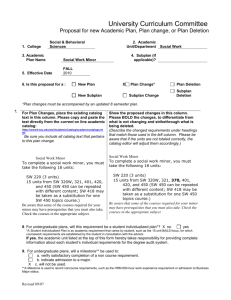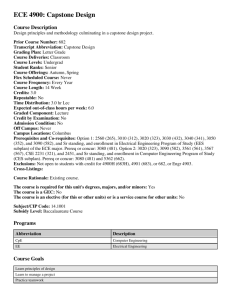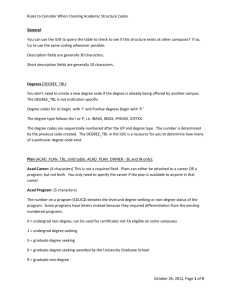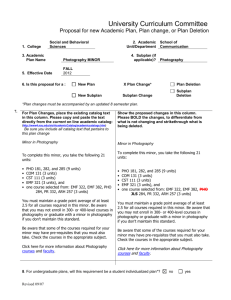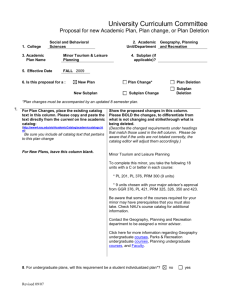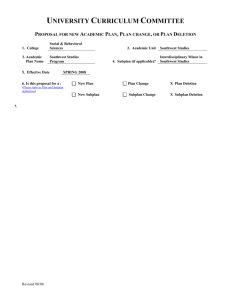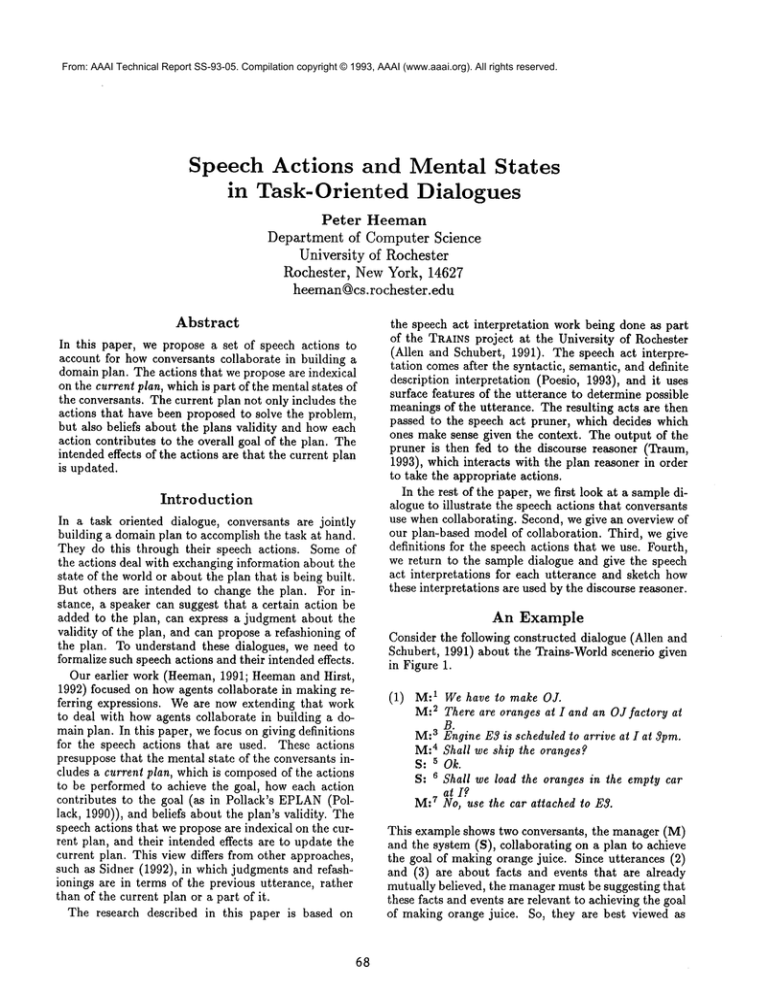
From: AAAI Technical Report SS-93-05. Compilation copyright © 1993, AAAI (www.aaai.org). All rights reserved.
Speech Actions and Mental States
in Task-Oriented Dialogues
Peter
Heeman
Department
of Computer Science
University of Rochester
Rochester,
New York, 14627
heeman@cs.rochester.edu
Abstract
In this paper, we propose a set of speech actions to
account for how conversants collaborate in building a
domain plan. The actions that we propose are indexical
on the current plan, which is part of the mental states of
the conversants. The current plan not only includes the
actions that have been proposed to solve the problem,
but also beliefs about the plans validity and how each
action contributes to the overall goal of the plan. The
intended effects of the actions are that the current plan
is updated.
Introduction
In a task oriented dialogue, conversants are jointly
building a domain plan to accomplish the task at hand.
They do this through their speech actions. Some of
the actions deal with exchanging information about the
state of the world or about the plan that is being built.
But others are intended to change the plan. For instance, a speaker can suggest that a certain action be
added to the plan, can express a judgment about the
validity of the plan, and can propose a refashioning of
the plan. To understand these dialogues, we need to
formalize such speech actions and their intended effects.
Our earlier work (Heeman, 1991; Heemanand Hirst,
1992) focused on how agents collaborate in making referring expressions. Weare now extending that work
to deal with how agents collaborate in building a domain plan. In this paper, we focus on giving definitions
for the speech actions that are used. These actions
presuppose that the mental state of the conversants includes a current plan, which is composedof the actions
to be performed to achieve the goal, how each action
contributes to the goal (as in Pollack’s EPLAN
(Pollack, 1990)), and beliefs about the plan’s validity. The
speech actions that we propose are indexical on the current plan, and their intended effects are to update the
current plan. This view differs from other approaches,
such as Sidner (1992), in which judgments and refashionings are in terms of the previous utterance, rather
than of the current plan or a part of it.
The research described in this paper is based on
68
the speech act interpretation work being done as part
of the TRAINSproject at the University of Rochester
(Allen and Schubert, 1991). The speech act interpretation comes after the syntactic, semantic, and definite
description interpretation (Poesio, 1993), and it uses
surface features of the utterance to determine possible
meanings of the utterance. The resulting acts are then
passed to the speech act pruner, which decides which
ones make sense given the context. The output of the
pruner is then fed to the discourse reasoner (Traum,
1993), which interacts with the plan reasoner in order
to take the appropriate actions.
In the rest of the paper, we first look at a sample dialogue to illustrate the speech actions that conversants
use when collaborating. Second, we give an overview of
our plan-based model of collaboration. Third, we give
definitions for the speech actions that we use. Fourth,
we return to the sample dialogue and give the speech
act interpretations
for each utterance and sketch how
these interpretations are used by the discourse reasoner.
An Example
Consider the following constructed dialogue (Allen and
Schubert, 1991) about the Trains-World scenerio given
in Figure 1.
(1) M:1 We have to make OJ.
M:2 There are oranges at I and an O J factory at
B.
M:3 Engine E3 is scheduled to arrive at I at 3pm.
M:4 Shall we ship the oranges?
S: 5 Ok.
S: 6 Shall we load the oranges in the empty car
at I?
M:7 No, use the car attached to E3.
This example shows two conversants, the manager (M)
and the system (S), collaborating on a plan to achieve
the goal of making orange juice. Since utterances (2)
and (3) are about facts and events that are already
mutually believed, the manager must be suggesting that
these facts and events are relevant to achieving the goal
of making orange juice. So, they are best viewed as
OJ
Factoryl
City
Orange
Source City
B
I
D empty car
Engine E3
empty car
City G
BananaSource
Figure 1: Trains World Scenario
suggestions to incorporate the facts or events into the
plan.
Utterance (4) is also such a suggestion, but is uttered
as a yes-no question. What is it questioning? One gloss
of this utterance is that the yes-no question is questioning whether the suggestion is acceptable. But this interpretation ignores how the suggestion is embeddedin
the current plan: that the oranges will be shipped with
engine E3 from city I to city B and that E3 will be at
I by 3 pm. It is this context, all of the facts and events
that are related to the suggestion by way of the current
plan, that is being question, not just whether the oranges should be shipped. So, this utterance should also
be interpreted as a request for judgment of the part of
the plan that deals with shipping the oranges.
In utterance (5), the system utters ’ok,’ thereby accepting the shipping subplan. Then in (6), the system
suggests that they load the oranges into the empty car
at I. This suggestion is uttered as a yes-no question,
and as above, we view it as also a request for a judgement of the part of the plan that involves loading the
oranges into the empty car. In utterance (7), the manager rejects the proposed subplan, and modifies it by
suggesting an alternate car to load the oranges into,
the car attached to E3.
With our model, the current plan is being updated
after each utterance. Suggestions add additional actions, facts, or subgoals to the plan; judgments express
the speaker’s beliefs about the validity of the plan, and
requests for judgments add discourse obligations for the
hearer to express his views about the plans validity.
A Plan-Based
Model
of
Collaboration
Clark and Wilkes-Gibbs (1986) investigated howparticipants in a conversation collaborate in makinga refer-
69
ring action successful. They found that after the initial
referring expression was presented, the other participant would pass judgment on it, either accepting it, rejecting it, or postponing his decision. If it was rejected
or the decision postponed, then one participant or the
other would refashion the referring expression. This
wouldtake the form of either expanding it by adding further qualifications, or replacing the original expression
with a new expression. The referring expression that
results from this is then judged, and the process continues until the referring expression is acceptable enough
to the participants for current purposes.
Fromthe above description, we can see that each step
in the acceptance process has a referring expression associated with it. The judgment moves serve to judge
the expression, while the refashioning moves serve to
refashion it, resulting in the referring expression that is
associated with the next turn. This view led us (Heeman, 1991; tIeeman and Hirst, 1992) to propose that
the current referring expression is part of the state of
the collaborative process, along with beliefs about its
validity. Besides having an intention to achieve the goal
of the collaborative activity, the participants, in order
to co-ordinate their activity, have intentions to keep the
state in their commonground. So, the judgment and
refashioning movesserve to fulfill these intentions.
Our earlier work further lends itself to task-oriented
dialogues since we viewed referring expressions as plans
that conversants collaborate upon. A judgment move
is uttered with the intent to makeit mutually believed
whether the current plan is valid or not, and a refashioning move serves to update the current plan. Since
the two agents are collaborating, neither one is explicitly controlling the conversation. So, we proposed that
as long as a judgment or refashioning is understood, the
hearer will tend to accept it, and update the common
ground accordingly. Disagreements are handled by subsequent judgments and refashioning of the plan, rather
than by judgments and refashionings of the previous utterance. So, the current plan, which is in the common
ground of the participants, need not be valid, only that
the system be able to find it coherent (Pollack, 1990).
The plan representation proposed by Ferguson (1992)
allows such plans to be represented, as well as partial
plans.
The
Speech
Actions
We now need to adapt the model of Heemanand Hirst
for use in collaborative task-oriented dialogues in general, rather than just referring expressions. Our approach is to give definitions for the speech actions, and
to state their intended effect on the mental state of the
participants. This of course will not be a full classification of the speech actions that can be realized in
such dialogues, but only the more central ones that are
needed to account for the conversation given above.
Weneed to account for four different operations that
speakers can perform on the current plan. They can
suggest (or request) additions to the plan, request judgment of the plan (or subplan), make judgments, and
make replacements. Furthermore, they can restrict
their attention to just a portion of the plan, usually
the part of the plan that is relevent to the last addition to the plan. Wewill refer to this as the subplan
in focus. So, the discourse reasoner, with the help of
the plan reasoner, will need to keep track of this. Also,
to account for the coherency across multiple speech actions, discourse expectations and obligations will need
to be inferred from the speech actions. For instance,
a request for judgment of the subplan in focus gives
rise to a discourse expectation in the speaker that the
hearer will judge the subplan. Likewise, the hearer will
have a discourse obligation. This will also need to be
kept track of by the discourse reasoner.
Our definition of the speechacts uses a typed Prolog
that allows functional roles (variables are indicated with
a leading ’?’). Each speech act type has a role for the
speaker, hearer, time, and its content. Below, we will
give the content of the speech actions. The content
is expressed in a logical form language (Allen, 1992),
which will be explained as needed. Definitions of the
speech acts have been simplified by removing discourse
markers and references to time.
Additions
event type as its first parameter, and a plan as its second.
Requests
for
Judgment
The second plan operation is a request for a judgment
of a subplan of the current plan. These are usually
uttered in combination with a suggestion, by using the
modal verb ’shall’ followed by someaction. In this case,
the request for judgment is of the subplan dominated
by the suggestion. Such speech actions must add a discourse expectation/obligation that the next utterance
will be a judgment of the subplan for which judgment
was requested. Belowis the content of a request for an
acceptance.
(: content ?e,t-request
( : Occurs
( : lambda?acc*t-accept
(:and
(: focus-subplan ?subplan)
( : content ?acc ?subplan)) )
The content uses the : occurs logical form, which takes
as its argument a speech act type. In this case it is
an accept speech act whose content is the subplan that
is in focus. So, this speech action is requesting the
occurrence of an acceptance of the subplan in focus.
to the Plan
Whena speaker mentions a fact, event, or goal, one interpretation for this utterance is that it is a suggestion
to use that fact, event, or goal in the plan3 Werepresent this by using the suggest speech act. The content
of this act is a relationship between the content of the
utterance and the current plan. For instance, a suggestion of a fact is expressed as the relationship that the
current plan uses some object (which is derived using
focus heuristics from the utterance that the fact was
uttered in) in the context expressed by the fact. Given
below is the speech act interpretation of a suggestion
to use some object, ?obj in the plan, where ?fact corresponds to the context that the object was mentioned
in.
(: content?e,t-suggest
( :the?p,t-plan
( : current-plan
?p)
(:uses?obj*t-object
?fact ?p)))
Note that the :usespredicate is embeddedinside of the
quantifier :the. This quantifier takes three parameters,
the first is the variable, the second, the restrictions, and
the third is the expression that is being quantified. This
is used in the example above in order to refer to the
current plan.
For expressing that an event should be added to the
plan, we use the relation :event-in, which takes an
1 Speakerscan also be moredirect and request that a fact,
event, or goal should be used in the plan.
7O
Judgments
The intended effect of a judgment is to make it mutually believed that the current plan, or part of it, is or
is not acceptable. Judgmentstypically follow a request
for a judgment, and so the part of the plan that is being
judged is given by the discourse expectations or obligations. Otherwise, the utterance itself will include some
reference that indicates the scope of the judgment, such
as "that sound’s good". If the judgment is a rejection,
then a discourse expectation/obligation will be added
that the next utterance will be a replacement to the
subplan. Given below is an example of the content of a
rejection (acceptances are practically identical).
(:content?e,t-reject
(: lambda?p,t-plan
( : focus-subplan
?p))
The content of a judgment uses the : lambda operator in
order to specify what part of the plan is being judged.
Replacements
Replacements are used to fix a subplan that was rejected. At the surface level, they are identical to the
suggestions mentioned earlier, and so we rely on discourse expectations in order to disambiguate them. Our
approach to replacements is to treat them as the conjunction of an addition to the plan and an argumentative speech action (Traum and Hinkelman, 1992).
The argumentative action will be a replace speechact,
which takes two roles, one for referring to the speech
action that is being used to make the addition, and the
second for referring to the judgment speech act. The
judgmentspeech act is specified since it might indicate
which part of the subplan that the replacement should
happen in. Note that it is left to the plan reasoner
to decide how to best incorporate the replacement into
the subplan. Given below is the role information for a
sample replacement.
(:role?e :r-replaced?er*t-reject)
(:role ?e :r-replacement
?es*t-suggest)
The Example
Wenow work through the example, giving the speech
acts for each utterance. In addition, we take the viewpoint of the system, and show how the speech act interpretations can be used by the discourse reasoner, or
generated by it.
In the first utterance the managerintroduces the goal
to be achieved, and so begins the collaborative activity.
The next utterance expresses knowledge about the
world. This utterance could be either an inform, or a
suggestion that the oranges and OJ factory are relevant
to the plan. Since these facts are mutually believed by
both participants, the speech act pruner will remove
the former interpretation. So, we give only the speech
acts for the latter.
M:2 There are oranges at I and an O J factory at
B.
(:content
[ST-SUGGEST-O006]
(:the ?p,t-plan
(:current-plan
?p)
(:uses[Xl.2] (:at [Xl.2][STN-I])?p)))
(: current-plan
?p)
( :uses[ENG3]
( : occurs
(:lambda?e,t-arrive
(:and
(:role?e :r-object[ENGS])
(:role?e :r-location[STN-I])
(:role?e :r-time[SPM]))))
?p)))
The fact that the engine is schedule to arrive at I at
3pmis represented by the occurrence of an arrival event
type. The operator : occurs takes an event type. Event
types are built using the : larabda operator, which takes
an event variable as its first parameter, and restrictions
as its second. This allows an arrival event at [STN-I]
at [SPM]of [E~IGS]to be specified.
These speech act interpretations are given to the discourse reasoner, which will use the plan reasoner to incorporate them into the current plan. This will result
in the plan having the fact that there are oranges at
I, an orange juice factory at B, and that engine E3 is
scheduled to arrive at I at 3pm. The plan reasoner, in
order to makethe plan coherent, will postulate that the
oranges at I are to be used to make orange juice and
that engine E3 will be used to move them from I to B
(Ferguson, 1992).
In the fourth utterance, the manager asks if they
should ship the oranges. Twoof the speech act interpretations for this utterance are that it is a suggestion
to ship the oranges and a request for a judgment of
the subplan dominated by the action of shipping the
oranges.
M:4 Shall we ship the oranges?
(: content[ST-SUGGEST-O009]
( :the?p,t-plan
( : current-plan
?p)
(:uses [XI.3] (:at [XI.3] [STN-B])?p)))
So, the speech act interpretation is that there are two
suggestions, one that the current plan uses the oranges,
whose discourse marker is [Xl.2], and that these oranges are at I, [STN-I]; and the second is that the
current plan uses the OJ factory, [Xl.3], which is at
B, [STN-B].
The third utterance is similar to the second. Below
is the speech act interpretation that it is a suggestion
to use engine E3 in the plan.
M:3 Engine E3 is scheduled to arrive at I at 3pm.
(:content[ST-SUGGEST-O014]
(:the ?p,t-plan
(:current-plan
?p)
(:event-in
(:lambda?e,t-bring-about
(:and
(:role?e :r-agent[SYSHUM])
(:role?e :r-event
(:lambda?em*t-move-commodity
(:role?em :r-commodity[XI.2]))))))
?p)))
(:content[ST-REQUEST-O015]
(:OCCURS
(:lambda?e,t-accept
(:and
(:focus-subplan
?subplan)
(:content?e ?subplan)
(:role ?e :r-speaker[SYS])))))
These speech act interpretations
will be passed to
the discourse reasoner, which will use the plan reasoner
(:content
[ST-SUGGEST-O012]
(:the ?p,t-plan
71
to incorporate the suggestion into the plan. Assuming
that this is successful and creates no difficulties, the
discourse reasoner can accept the resulting subplan.
Since the system found the suggestion to be acceptable, it responds with "OK.", and so accepts the subplan. The content of the accept is the subplan in focus.
(:current-plan
?p)
(:uses[C2] 7x,t-anything?p)))
(:role[ST-REPLACE-O030]
:r-replaced[ST-REJECT-O025])
(:role[ST-REPLACE-O030]
: r-replacement
[ST-REQUEST-O030)
The system invokes the plan reasoner in order to find
an appropriate part of the subplan and to replace it by
the specified boxcar.
(:content[ST-ACCEPT-O017]
( :lambda?p,t-plan
( : focus-subplan
?p))
Discussion
Thesystemthenreasons
abouttheplanandsuggests
loading the oranges into a specific boxcar, and requests
a judgment about this subplan.
S: 6 Shall we load the oranges in the empty car
at I?
(:content[ST-SUGGEST-O019]
(:the ?p,t-plan
(:current-plan
?p)
(:event-in
(:lambda?e,t-load
(:and
(:role?e :r-agent[SYS])
(:role?e :r-commodity[XI.23)
(:role?e :r-car[C1])
?p)))))
(:content[ST-REQUEST-O020]
(:occurs
(:lambda?e,t-accept
(:and
(:focus-subplan
?subplan)
(:content?e ?subplan)
(:role?e :r-speaker[SYS])))))
The manager however r~ects the subplan and suggests, as a replacement to the subplan, to use an alternate boxcar.
M:~ No, use the car attached to E3.
This is interpretated as a r~ection of the subplan in
focus, a request that the current plan uses the car attached to E3, [C2], and that this request should be a
replacement to the subplan in focus in order to correct
the plan.
(:content[ST-REJECT-O025]
(:lambda?p,t-plan
(:focus-subplan
?p)))
(:content[ST-REQUEST-O029]
(:the ?p,t-plan
72
In this paper, we presented a set of speech actions for
representing how conversants collaborate in task oriented dialogues. These actions are indexical on the
current plan. Suggestions of facts and events are interpreted as suggestions that these facts and events be
incorporated into the current plan. Judgments and requests for judgments are about the current plan, or at
least that part which is relevant to the current conversation. Likewise refashionings are about replacing one
part of the plan with something else. So, the current
plan captures the state of the collaborative activity, and
is assumed to be in the commonground of the conversants.
Our work differs from other approaches to modeling collaboration in dialogues. In particular, Sidner
(1992) emphasizes the role of utterances. Her speech
acts, which are part of an artificial language designed
to model collaborative dialogues, are concerned with
making individual beliefs mutually believed, without
reference to a current plan. For instance, she has the
action ProposeForAccept, which is used to propose
that somebelief be mutually believed; Reject, which is
used to make it believed by the hearer that some belief
that has been proposed is not believed by the speaker;
and Counter, which is used to replace a belief that the
hearer has proposed by one that the speaker is proposing. So, any notions of howactions relate to other actions that have already been proposed are not captured,
and so she must rely on a general belief revision system
rather than taking advantage of more directed plan reasoning mechanisms.
Our work also differs from Traum’s work (1991)
reaching mutual understanding in dialogues. In representing the current state of a dialogue, Traum proposes a number of different plan spaces, corresponding
to whether a plan (or action) is just privately held,
has been proposed, acknowledged, or accepted. Our
work assumes a much simpler model. Once a proposal
has been uttered, it is incorporated into the current
plan, so long as this can be done coherently. So, judgments about the proposal and refashionings to it are
carried out with respect to the current plan, which corresponds to Traum’s accepted plan space. So, unless a
proposal cannot be understood, it would move directly
from privately held to the accepled plan space.
Future
Work
Much work remains to be done. Foremost, we need to
re-examine judgments and requests for judgments. We
have proposed that these actions are about the subplan
in focus. However,there is the other speech act interpretation: that the judgment or request for judgment
is about the specific utterance, regardness of howit fits
into the current plan. Weneed to account for how these
two speech act interpretations affect each other. Second, we need to further explore the notion of a subplan
in focus, and how this focus shifts during a conversation. Third, we need to give a formal account of the
speech actions that we presented, including their effect
on the mental state of the agent and the discourse expectations and obligations that can arise from them.
Fourth, we need to verify our results against a corpus
of task oriented dialogs, a task that has already been
started.
Acknowledgments
I wish to thank my supervisor, James Allen, for enlightening discussions. Also, thanks to David Traum,
Hannah Blau, George Ferguson, and Massimo Poesio. Funding gratefully
received from the Natural Sciences and Engineering Research Council of
Canada, from NSF under Grant IRI-90-13160, and from
ONR/DARPA
under Grant N00014-92-J-1512.
References
Allen, J. F. (1992). Users guide for using RHETlogical
forms. Unpublished Manuscript.
Allen, J. F. and Schubert, L. K. (1991). The TRAINS
project. Technical Report 382, Department of
ComputerScience, University of Rochester.
Clark, H. H. and Wilkes-Gibbs, D. (1986). Referring
a collaborative process. Cognition, 22:1-39.
Ferguson, G. M. (1992). Explicit representation
events, actions, and plans for assumption-based
plan reasoning. Technical Report 428, Department
of Computer Science, University of Rochester.
Heeman,P. A. (1991). Collaborating on referring expressions. In Proceedings of the 2gth Annual Meeting of the Association for Computational Linguislics, Student Session, pages 345-346.
Heeman, P. A. and Hirst, G. (1992). Collaborating
on referring expressions. Technical Report 435,
Department of Computer Science, University of
Rochester.
Poesio, M. (1993). Definite descriptions and the dynamics of mental states. In Working Notes AAAI
Spring Symposium on Reasoning about Mental
Slates: Formal Theories ~ Applications, Stanford.
Pollack, M. E. (1990). Plans as complex mental attitudes. In Cohen, P. R., Morgan, J., and Pollack,
73
M. E., editors, Intentions in Communication, SDF
BenchmarkSeries, pages 77-103. MIT Press.
Sidner, C. L. (1992). Using discourse to negotiate in collaborative activity: An artificial language. In Proceedings of the Workshop on Cooperation among
Heterogeneous Intelligent Agents. AAAI-’92.
Traum, D. R. (1991). Towards a computational theory of grounding in natural language conversation.
Technical Report 401, Department of Computer
Science, University of Rochester.
Traum, D. R. (1993). Mental state in the TRAINS-92
dialogue manager. In Working Notes AAAI Spring
Symposium on Reasoning about Mental States:
Formal Theories ~J Applications, Stanford.
Traum, D. R. and I-Iinkelman, E. A. (1992). Conversation acts in task-oriented spoken dialogue. Computational Intelligence, 8(3).

